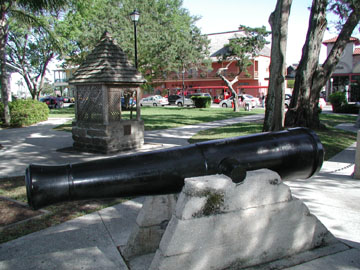Here, America’s colonization began first and the so-called ‘Ancient City” has all the charm and history of a European fishing village from the 16th century. From the oldest masonry fort in America to its first shopping center, the city contains a chronicle of American history from native America to modern, with stops at every turn in history.
Just a mile north of the Usina bridges terminus at the foot of St. Augustine, lies Fort Mose, a National Historic Landmark, and one of the most important sites in American history: the first free community of ex-slaves, founded in 1738 and called Gracia Real de Santa Teresa de Mose or Fort Mose (pronounced Moh-Say).
Castillo de San Marcos, the third incarnation of a twice-burned wooden fort, changed the course of building in Florida with stone masonry utilizing coquina rock, nature manufactured porous stone created from the fossils sea life. Quarried or mined and used as a building stone in Florida for over 400 years, the stone makes an excellent building block for defensive structures like forts, particularly those built during the period of heavy cannon use. Because of coquina's softness, cannon balls would sink into, rather than shatter or puncture, the walls of the Castillo de San Marcos. Across the street from the fort, on A1A, is America’s first continuous European settlement, St. Augustine.
Shoppers, antique collectors, art lovers, attraction fans and foodies will find much to tempt the eye, the mind and the palette in and around America’s first European marketplace, along St. Georges Street adjacent to the A1A Byway. The great pleasure of St. Augustine is that even today, the place and feel embody the spirit of a long-established European settlement with an almost other-worldly separateness from the rest of the country.
The city is a popular tourist attraction, for its Spanish Colonial buildings as well as elite 19th-century architecture. The city's historic center is anchored by St. George Street, which is lined with historic homes from various periods. Some of these homes are reconstructions on the original site, many are original. The city is one terminus of the Old Spanish Trail, a promotional effort of the 1920s linking St. Augustine to San Diego, California with 3,000 miles (4,800 km) of roadways.
More can be found here regarding the city and its pivotal role in America’s history.
Visitor Tip
28 miles: heading south on the byway.
Ponce de Leon's Fountain of Youth National Archaeological Park:
Seeking the Fountain of Youth and believing he had found it, Ponce de Leon may have landed here in 1513 and planted a stone cross into the ground. www.fountainofyouthflorida.com/index.php
Mission de Nombre de Dios:
In 1565, Pedro Menendez de Aviles landed at what became the Mission de Nombre de Dios and claimed this site for Spain and the Church. It was on these grounds that Father Lopez would celebrate the first parish mass in the New World.
Points Of Interest
- Ponte Vedra Beach
- Bird Island Park
- Mickler’s Landing
- Guana Tolomato Matanzas
- Guana Tolomato Matanzas Environmental Ed Center
- Nease Beachfront Park
- Vilano Beach
- Colonial St. Augustine
- St. Augustine
- The Flagler Factor
- America’s Tourism Capital 1890-1930
- Anastasia Island
- Fort Matanzas – National Monument
- Marineland and UF Whitney Lab
- Washington Oaks Gardens State Park
- Malacompra Plantation Archaeological Site
- Betty Steflik Memorial Reserve
- Flagler Beach Pier
- Gamble Rogers Memorial State Park



